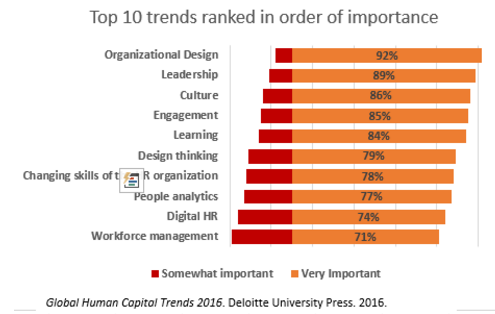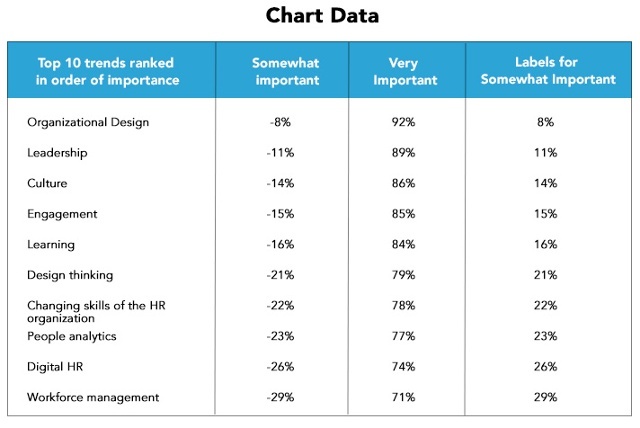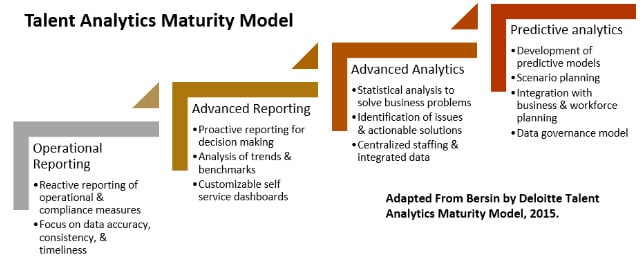
On the leading edge of human capital management, a transformation is gaining momentum. The role of human resources leaders is changing from:
- caretaker of employee welfare to designer of the employee experience,
- service provider to cultural consultant,
- pursuit of efficiency to adding value to the business, including impact on top line results.
Human capital analytics is driving the transformation.
In Deloitte’s top 10 concerns of global business leaders, people analytics ranks 8th (Fig 1), but in our minds, analytics are essential to each of them. When you dig into the details, skilled application of analytics impels, influences, or even creates the momentum in every area of concern. People analytics will soon be at the center of everything in human capital.

It wasn’t until analytical experts and academics widely published results of employee engagement studies that the majority of business leaders saw the clear connection between engagement and performance. Culture wasn’t something CEOs thought much about until human capital analysts showed them how much it matters to the ability to attract, motivate, and retain talented people.
As innovators in human capital analytics have shown the way, more and more companies are developing the capability to develop powerful insights into their activities and processes.
- Analytical models predict which candidates will succeed far better than the judgment of hiring managers.
- Knowing in advance which candidates are more likely to stay reduces turnover costs.
- Indicators of flight risk enable targeted retention interventions.
The Analytics Wave
Thinking of the momentum in people analytics, we picture surfers at the Banzai Pipeline in Hawaii. The waves begin as far-off gentle swells, but as they race toward shore, up the sloping sea bottom, the water piles up into the giant curling monsters only champion surfers dare to challenge. At the opposite side of Oahu, beginners ride tiny waves at Waikiki.
You can start at the Pipeline if you have the budget, an experienced analytics team, and the solid backing of your CXOs. But most need to begin with a gentler ride.
Almost everyone we talk to is at the basic level of talent analytics (Fig 2) and moving into advanced reporting for better decision-making. They are just taking their first steps to develop their analytical capability. The question today is how a CHRO on the ground level can catch the wave.
Getting Started with Analytics
Getting started in people analytics requires a change in mindset. Instead of trying to prove the value of HR, think about how to help business leaders succeed. Leave HR jargon in HR, and start talking business.
- Partner with Marketing and Finance. They have been using analytics for a long time and can help pave the way. Engage your CFO in discussions about the impact of human capital on business results.
- Engage a human capital analyst. If you don’t have an expert in the organization, you can find many competent consulting companies, from single practitioners to global firms.
- Plan your strategy. Work with your consultant to determine what your development path will be over the long term.
- Focus conversations with operational and functional leaders on organizational performance. Working with them, isolate a human capital problem and define it in terms of financial impact on the business.
- Assemble the data and analyze the problem. Don’t be surprised if you must stop and clean up your data before you begin.
- Create a hypothesis and design your intervention. Use predictive analytics to determine the best probability of success.
- Test your hypothesis, with a pilot group or small intervention.
- Analyze the result in terms of financial impact on the business.
- Tell the story. Communicate the results to your executive team so they will back your continued efforts.
- Fine tune your process and repeat.
Start with a small wave and build your team. In time, you too will challenge the Pipeline.
References :
a) Source of Chart Data : Global Human Capital Trends 2016. Deloitte University Press 2016.

Phenomecloud is a full-service technology company dedicated to helping clients solve business problems, improve the capability of their people, and achieve better results.






Leave a Comment